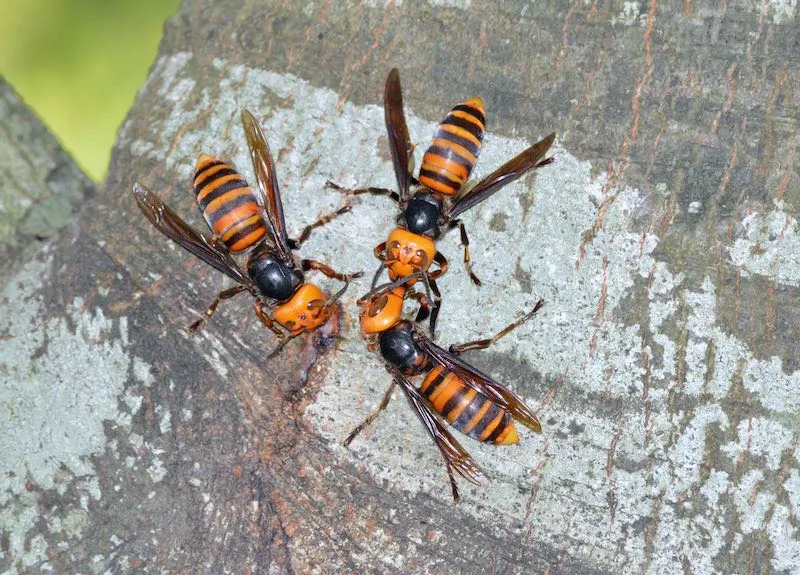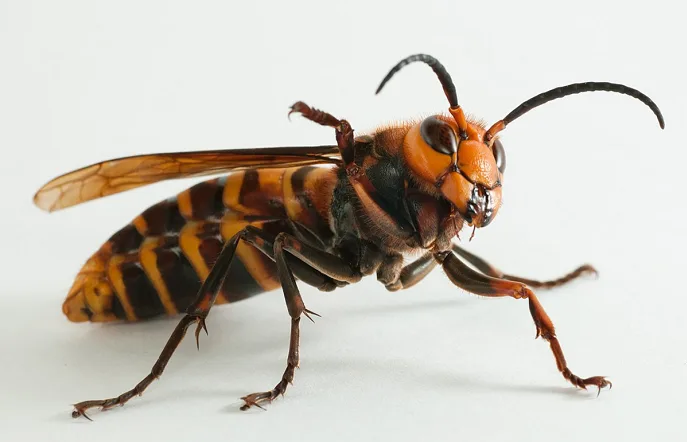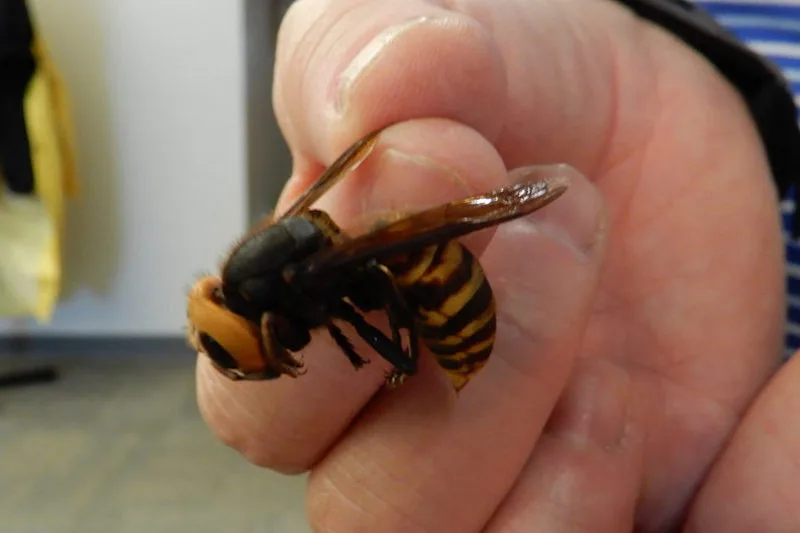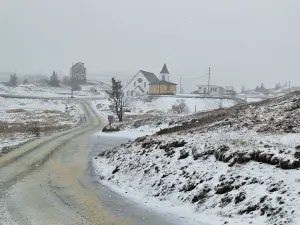
Asian giant hornets: A lot more buzz than sting, experts say
The Asian giant 'murder' hornet has garnered an overhyped reputation since news spread this month of its presence in North America.
The so-called ‘murder hornets’ don’t live up to that designation and the experts who have been asked at great lengths about that particular type of insect in recent weeks are downplaying the ostentatious buzz its created.
While the Asian giant hornet, or its scientific name of Vespa mandarina, is invasive, you don’t need to become frightened over the bright-coloured, two-inch insect that seemingly took North America by storm, in hype that is, lately. Instead, Canadians should focus their concerns on more threatening invasive species such as the emerald ash borer, Japanese knotweed, round goby or garlic mustard, just to name a few.
RELATED: Invasive Asian 'murder' hornets pose serious threat to honeybee populations
In response to the widespread media coverage, The Weather Network reached out to several biologists and entomologists through email for a Q-and-A on the Asian giant hornet to clear up misconceptions people may have on the insect.
The following experts chimed in with their thoughts: University of Manitoba entomologist Robert Currie, University of New Brunswick biology professor Stephen Heard, retired University of Guelph professor Gard Otis, an expert in honeybee biology and insect ecology, Western University biology professor Brent Sinclair and Winnipeg entomologist John Gavloski.
Disclaimer: Responses from the experts remained intact, other than minor corrections for grammar.

Asian giant hornet. Photo Wikimedia Commons.
Question: The way the public has grabbed on to the nickname has brought mass attention to the bugs, perhaps too much and in the wrong way. Has the term overblown the threat?
Heard: It's not the public; it's the media, [who] have seized on the name. Then, understandably, the public sees the name everywhere and gets concerned. The bad side of this is that people might pay attention to this species and ignore the real threats to our ecology and economy posed by invasive species that actually are a problem. The good side, if there is one, is that it permits the kind of conversation we're having right now – about invasive species in general.
Currie: The term ‘murder hornet’ caught the attention of the media when an article was published in the New York Times. It is not the official common name of the insect assigned by entomologists. The name is overblown when you compare the numbers of humans that die from stings of this species of hornet, [which] is low compared to other deaths from stinging arthropods. The effects on beehives can be quite devastating, however, and so their “murderous” moniker might be more relevant to a description of their impact when attacking individual honeybee colonies.
Otis: Yes, I feel that people have freaked out unnecessarily. In the past week, there have been hundreds of reports of many different kinds of insects, not one of which has been an Asian giant hornet. In many cases, relatively harmless pollinators have been unnecessarily killed. If an insect is not huge – 4-5 centimetres long (nearly 2 inches long) – it is not an Asian giant hornet.
Gavloski: There has been a lot of over-sensationalizing of this insect and the nickname has possibly added to this.
Sinclair: Of course it has, but this happens all the time. Think about sharks or snakes and the unfair bad rap they always get. The media hasn’t exactly helped, though.
Question: How dangerous are these hornets to people across Canada?
Otis: Currently, Asian giant hornets are so rare in Canada that they pose a minuscule risk to humans. Even if they do become established over the coming years, individual Asian giant hornets are docile and pose no threat to humans. During my research on Asian giant hornets in Vietnam, I spent 30 days in close proximity to beehives being visited by hornets. I routinely had to hit them to get them to move away from hives, yet not one ever attempted to sting me. In contrast, because they usually nest in the ground, stepping on or disturbing a colony would be extremely dangerous, especially in late summer or fall when the hornet colonies may contain 300-1,000 adult hornets.

Asian giant hornets, despite recent media coverage, don't pose a serious threat to Canadians. Photo: Getty Images.
Gavloski: Like our native species of hornets, Asian giant hornets would rather not mess with people, and would likely only do so if they felt threatened. They nest in the ground. A single sting is not likely to be serious unless a person is allergic to the stings. Advice in China is that people stung more than 10 times should get medical help.
Currie: In terms of the sting, the level of venom toxicity is slightly less than in the honeybee. However, the Asian giant hornet injects a much larger quantity of venom with each sting. While a honeybee might inject up to 150 micrograms of venom, the Asian giant hornet would inject about 1,100 micrograms. In terms of the number of stings (assuming no previous allergy), a human can tolerate about 700 honeybee stings (seven to 10 stings per pound of body weight) before reaching a dose that would be fatal in half of the individuals stung. For the Asian Giant hornet, it would be recommended to seek medical attention if you receive [more than] 10 stings. [More than] 30 stings would likely require hospitalization.
Question: If the population of these hornets explodes across Canada, how serious is this for our ecosystem beyond the honeybees? What are the repercussions?
Heard: That's a sensationalist and hypothetical question. There is no near-term reason to worry about this species. There are many other invasive species having huge impacts right now - like emerald ash borer or Japanese knotweed, just to name two. That's where we should be putting our attention and our efforts [on]. Of course we should be vigilant so the hornets don't get established here, as we should with every other potentially invasive species, too.
Gavloski: This is speculative, as we are not expecting a population explosion of these hornets across Canada. As far as we know, the nest of Asian giant hornets that was found on Vancouver Island was destroyed. Where Asian giant hornet is native to in Asia, they prefer to live in forested and low mountain habitats. They almost completely avoid plains. They may be able to survive in some areas of Canada, but would likely not be as successful in areas such as the prairies. In areas where they could survive, they may be a concern for honeybees and some species of wasps. Aside from honeybees, should they establish, Asian giant hornets would likely prey on some of the species of hornets already in Canada.
Otis: It is important that people realize at this point there were only five confirmed records of Asian giant hornets in the Pacific Northwest last year. For Vespa mandarinia, there was one colony destroyed in Nanaimo [on] Vancouver Island, and several individual worker hornets found in White Rock, B.C., and nearby Blaine, Wash., could have been from the same hornet colony. There were a couple of other unconfirmed reports in Washington state. One single queen of the other species, Vespa soror (hornet species), was collected in Vancouver, B.C. At this point, no one knows if these hornets will successfully colonize North America. If either species does establish a sustainable population in the West, it is anyone's guess how common they will become and if/how they will affect the broader ecosystem.
Hornets are general predators of caterpillars, grasshoppers, crickets, spiders, etc., and from late summer into fall, of social insects like yellowjackets and honeybees. Depending on what they are preying upon, they could be considered harmful or beneficial insects – if they become established.

Experts don't believe the population of Asian giant hornets will surge across Canada. Photo: Getty Images
Sinclair: It’s extremely unlikely that the population will ‘explode.' There has been one colony found (and eradicated) in Canada, and they aren’t commonly intercepted, which means introductions are rare. Also, remember that they specialize on Apis mellifera (western honeybee), a commercial species, essentially livestock. If something happened that meant that Asian giant hornets established everywhere, they’d primarily be a problem for bees, and areas with a lot of beehives.
Question: How many people are killed by the invasive hornets every year (in North America)? Comparing them to the deaths caused by the stings of native wasps, hornets, bees.
Otis: There were less than 10 Asian giant hornets reported in North America last year and nobody was harmed. In Japan, China, Vietnam, and other Asian countries, people are killed every year, but there is no information on how many of those deaths involved a severe allergic reaction to the venom as compared to mass stingings of people who disturbed a nest of hornets. In Canada, about four people die per year on average, mostly due to severe allergic reactions to the venom of the insects.
Sinclair: As far as I know, zero people have been killed by these guys in North America. Even in Asia, I think that the numbers are very low. I did a very quick Google search, and according to the CDC (Center for Disease Control), 1,017 people died of bee/wasp/hornet stings in the U.S. in the 2000-2017 period. My guess is these were largely from anaphylactic shock. Some more quick searches suggest that this is about the same (or a bit less) as from dog bite.
Question: A video recently resurfaced of a praying mantis killing a 'murder hornet'. Are praying mantises our only natural defence against Asian giant hornets?
Gavloski: There are [more than] 2,400 species of mantises worldwide. Some species of praying mantis may be able to capture and use Asian giant hornets as food, but the reverse is true, as well. Large insects such as mantises are key protein sources that Asian giant hornets will capture and feed to queens and drone larvae. Mantises may catch and kill some Asian giant hornets, but likely would result in killing a very small portion of the population.
Heard: Good question. Because Asian Giant Hornets haven't [been] established widely in North America, we don't know what other species might evolve to eat them here. They will also, of course, have parasite and disease enemies. But the ecological interactions of species that invade new ranges are always in doubt until we see it happen.

Photo: Washington Invasive Species Council.
Some Japanese honeybees are learning to defend themselves against the hornets by trapping them in their nests in order to ‘cook’ them. How effective is this defence mechanism? Will this be something honeybees in North America learn to use in order to defend themselves?
Currie: The mechanism is fairly effective at killing individual wasps through the thermal defence. The bees are able to warm their thoraxes by decoupling their wings and vibrating their wing muscles to generate heat. Temperatures inside the ball of bees exceed 48°C, which is fatal to the hornet if it is exposed for enough time. In contrast, our species of honeybee found here in Canada is the European honeybee, and although it can warm its thorax via the same mechanism, it has limited capacity to use thermal defences against other insects. The European honeybee colonies in Asia, where the Asian giant hornet is found, do not exhibit this defence mechanism, so it is unlikely to be able to be utilized by bees currently found in North America (either learned or selected through evolutionary pressure).
Gavloski: This is an effective defence mechanism for Japanese honeybees, which have evolved in the same region as the Asian giant hornet and evolved mechanisms to deal with this threat. The western honeybee, the species that is kept by beekeepers in North America, is a different species and has not evolved these defensive behaviours. So they would not be as successful at protecting themselves from the Asian giant hornet should they have to.
Question: What should someone do if they spot a nest?
Currie: They should contact local authorities to confirm the identity and arrange for someone else to destroy it. The person to report sightings to will vary by province, but generally a report to the provincial apiarist will allow the appropriate people to take action. In British Columbia, where the hornet would most likely be encountered in 2020, people can report sightings to the Invasive Species Council of BC.
Sinclair: They probably haven’t. If they can get a photo, they could upload it to iNaturalist.org to get an identification. Most species of wasps and hornets want to be left alone, so maybe leave them alone? A licenced pest control professional can help take care of it. I expect that if they really are Asian giant hornets, the CFIA (Canadian Food Inspection Agency) will want to know.
Otis: If someone spots extremely large wasps, especially those going in and out of the ground or a hole in a tree, they should report the sighting to provincial Ministry of Agriculture for identification. Photos and specimens of the insects are particularly useful. At no time should anyone take any actions that could cause harm to themselves.
Thumbnail courtesy of Getty Images.










